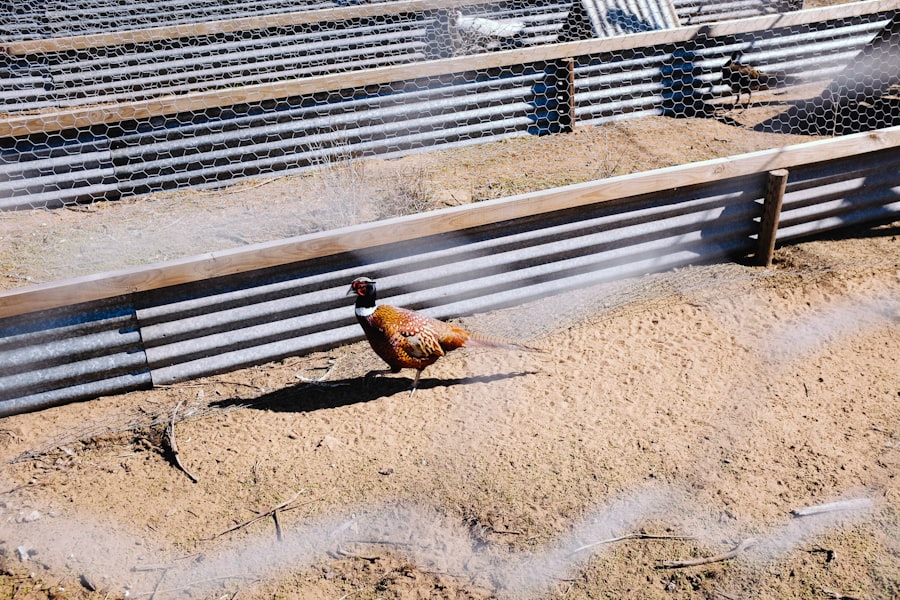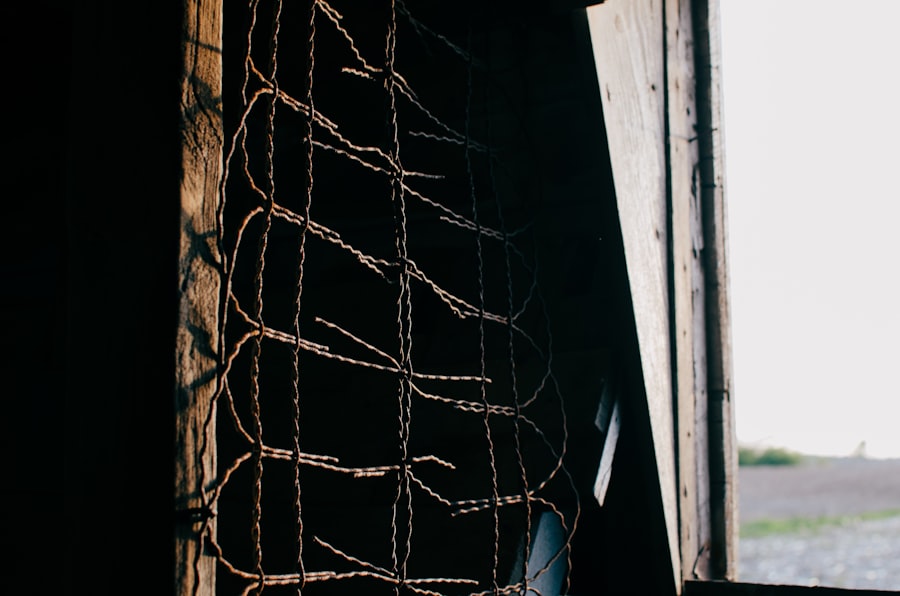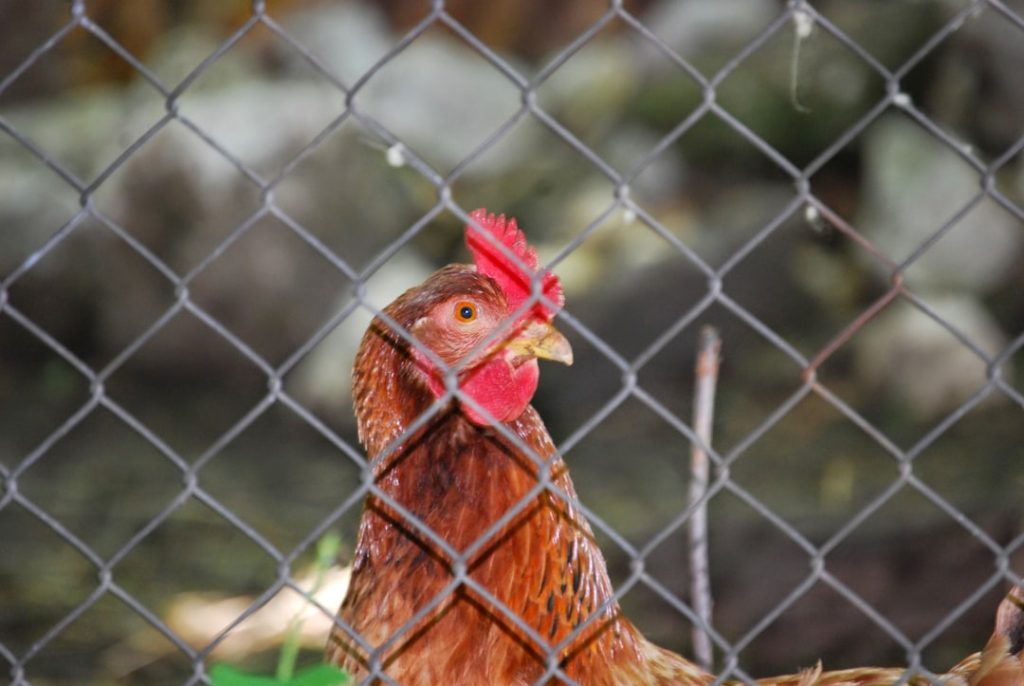Chickens are inherently inquisitive and gregarious creatures, frequently exploring their environment and engaging with other members of their flock. They are also known for their easily startled nature, often reacting to abrupt movements or loud sounds. Comprehending chicken behavior is essential for implementing effective containment strategies.
By studying their habits and patterns, one can better anticipate their movements and prevent them from entering undesired areas. Chickens possess a natural foraging instinct, which can drive them to explore beyond their designated spaces in search of food. Understanding this behavior allows for the creation of specific feeding zones, which can help keep chickens occupied and discourage wandering.
This knowledge of chicken behavior is crucial for developing successful methods to maintain them within designated areas, thereby preventing potential damage or disturbances.
Table of Contents
- 1 Implementing physical barriers
- 2 Utilizing scare tactics
- 3 Creating a designated chicken area
- 4 Implementing automatic doors and sensors
- 5 Using repellents and deterrents
- 6 Consistent maintenance and monitoring
- 7 FAQs
- 7.1 What are some effective methods for keeping chickens out of the barn?
- 7.2 Why is it important to keep chickens out of the barn?
- 7.3 What are some natural deterrents for keeping chickens out of the barn?
- 7.4 How can I train my chickens to stay out of the barn?
- 7.5 Are there any legal considerations for keeping chickens out of the barn?
Key Takeaways
- Chickens are naturally curious and will explore their surroundings, so understanding their behavior is crucial in preventing them from wandering into unwanted areas.
- Implementing physical barriers such as fences and netting can effectively keep chickens within designated areas and prevent them from accessing restricted spaces.
- Scare tactics such as motion-activated devices or visual deterrents can startle chickens and discourage them from venturing into prohibited areas.
- Creating a designated chicken area with proper fencing and shelter can help contain the chickens and minimize the risk of them straying into unwanted areas.
- Implementing automatic doors and sensors can help control the chickens’ access to certain areas, allowing for more efficient management of their movements.
Implementing physical barriers
Fences: A Key Component of Boundary Control
Fences can be constructed using materials such as wood, wire, or mesh, and should be tall enough to prevent chickens from flying over them. By creating boundaries, fences can prevent chickens from straying into unwanted areas.
Netting: A Protective Measure for Gardens and Flower Beds
Netting can also be used to cover areas such as gardens or flower beds to prevent chickens from accessing them. This is especially useful for protecting sensitive plants or crops from chicken damage.
Additional Barriers for Enhanced Control
In addition to fences and netting, other physical barriers such as gates or doors can be used to control the movement of chickens. By strategically placing gates or doors in key areas, it becomes possible to restrict access to certain areas while still allowing chickens to move freely within their designated space.
Utilizing scare tactics

Scare tactics can be an effective way to deter chickens from venturing into unwanted areas. There are various methods that can be used to scare chickens, such as using loud noises, motion-activated devices, or visual deterrents. For example, motion-activated sprinklers can be used to startle chickens when they approach a certain area, deterring them from entering.
Visual deterrents such as scarecrows or reflective tape can also be effective in deterring chickens by creating a sense of danger or unfamiliarity. Another effective scare tactic is the use of predator decoys, such as fake owls or hawks, which can create the illusion of a threat and deter chickens from approaching certain areas. By utilizing scare tactics, it becomes possible to deter chickens from straying into unwanted areas and keep them in designated spaces.
Creating a designated chicken area
Creating a designated chicken area is essential for keeping chickens in a controlled space and preventing them from causing damage or disturbances. This can be achieved by setting up a chicken coop or enclosure that provides ample space for chickens to roam and forage while still keeping them contained. The designated area should be equipped with food and water sources, as well as shelter to protect the chickens from the elements.
In addition to providing a designated area for chickens, it is important to establish clear boundaries and enforce rules for where they are allowed to roam. By creating a designated chicken area, it becomes possible to keep chickens in a controlled space and prevent them from straying into unwanted areas.
Implementing automatic doors and sensors
Automatic doors and sensors can be used to control the movement of chickens and prevent them from straying into unwanted areas. These devices can be programmed to open and close at specific times, allowing chickens to access certain areas while keeping them out of others. For example, automatic doors can be installed on chicken coops to allow chickens to access their designated area during the day and then close at night to keep them safe from predators.
In addition to automatic doors, sensors can also be used to detect the presence of chickens and trigger deterrents such as sprinklers or noise devices. By implementing automatic doors and sensors, it becomes possible to control the movement of chickens and prevent them from straying into unwanted areas.
Using repellents and deterrents

Types of Repellents
There are various types of repellents that can be used, such as sprays or powders that emit strong odors or tastes that deter chickens from approaching certain areas.
Ultrasonic and Noise-Making Deterrents
Additionally, deterrents such as ultrasonic devices or motion-activated noise makers can be used to startle chickens and deter them from straying into unwanted areas.
Natural Deterrents
Another effective method is the use of natural deterrents such as planting certain types of plants or herbs that are known to repel chickens. By using repellents and deterrents, it becomes possible to create an environment that discourages chickens from straying into unwanted areas.
Consistent maintenance and monitoring
Consistent maintenance and monitoring are essential for ensuring that strategies to keep chickens in designated areas remain effective over time. This includes regularly inspecting physical barriers such as fences or netting for any signs of damage or wear, and repairing or replacing them as needed. It also involves monitoring the effectiveness of scare tactics, repellents, and deterrents, and making adjustments as necessary.
In addition to maintenance, consistent monitoring of chicken behavior is important for identifying any potential issues or changes in their habits. By staying vigilant and proactive, it becomes possible to address any issues that may arise and ensure that strategies for keeping chickens in designated areas remain effective in the long term. Overall, consistent maintenance and monitoring are crucial for maintaining the effectiveness of strategies to keep chickens in designated areas.
If you’re looking for more tips on keeping chickens out of the barn, you might want to check out this article on how to convert a shed into a chicken coop. This article provides valuable information on creating a safe and comfortable space for your chickens, which can help prevent them from wandering into the barn. You can read the full article here.
FAQs
What are some effective methods for keeping chickens out of the barn?
Some effective methods for keeping chickens out of the barn include installing barriers such as fences or netting, using deterrents like motion-activated sprinklers or noise devices, and providing alternative areas for the chickens to roam and forage.
Why is it important to keep chickens out of the barn?
It is important to keep chickens out of the barn to prevent damage to stored items, contamination of feed and supplies, and potential health hazards from chicken droppings. Additionally, keeping chickens out of the barn can help maintain a cleaner and more organized workspace.
What are some natural deterrents for keeping chickens out of the barn?
Some natural deterrents for keeping chickens out of the barn include planting aromatic herbs such as lavender or mint around the barn, using citrus peels or vinegar as a repellent, and introducing predator decoys or natural predators like dogs or cats to the area.
How can I train my chickens to stay out of the barn?
Training chickens to stay out of the barn can be achieved through consistent reinforcement of boundaries, using positive reinforcement such as treats for staying outside the barn, and providing ample outdoor space and enrichment to keep the chickens occupied and content.
Are there any legal considerations for keeping chickens out of the barn?
Depending on local regulations and zoning laws, there may be legal considerations for keeping chickens out of the barn, especially if the chickens are causing damage to neighboring properties or posing a nuisance. It is important to be aware of and comply with any relevant laws or ordinances regarding the keeping of chickens.
Meet Walter, the feathered-friend fanatic of Florida! Nestled in the sunshine state, Walter struts through life with his feathered companions, clucking his way to happiness. With a coop that’s fancier than a five-star hotel, he’s the Don Juan of the chicken world. When he’s not teaching his hens to do the cha-cha, you’ll find him in a heated debate with his prized rooster, Sir Clucks-a-Lot. Walter’s poultry passion is no yolk; he’s the sunny-side-up guy you never knew you needed in your flock of friends!







